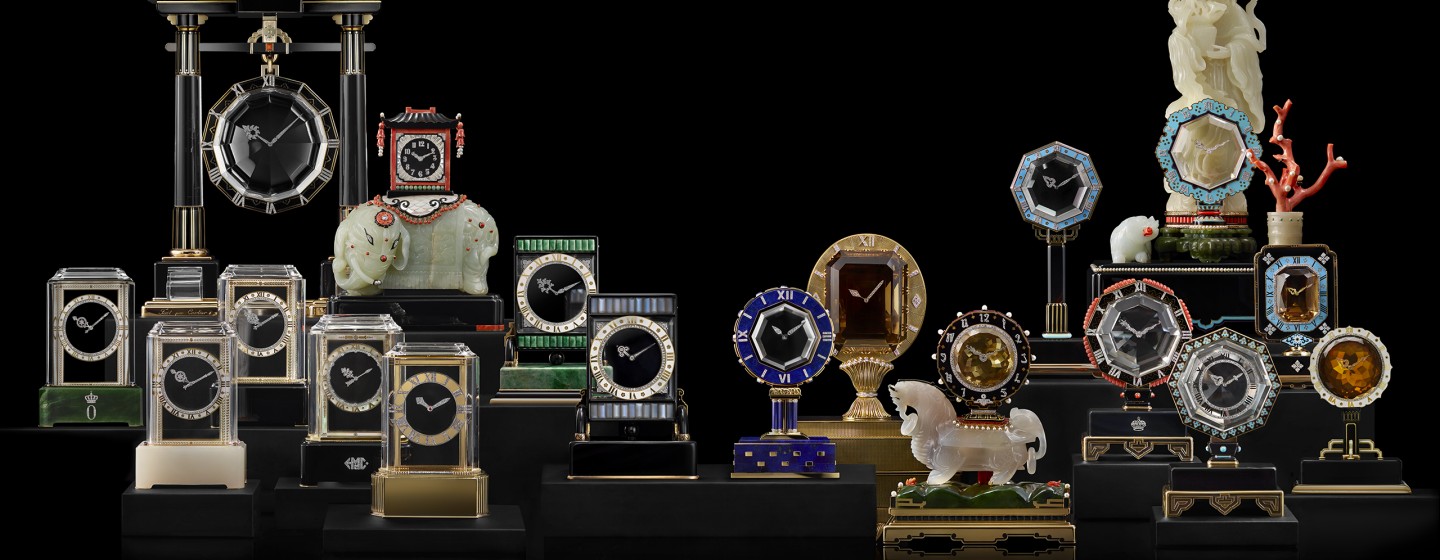
WATCHMAKING
From signature pieces – shaped watches, mysterious clocks and precious watchmaking – to creations which sparked an unprecedented creative vision in the field, the Collection tells the story of a unique 170-year history and encapsulates the pursuit of both aesthetics and technical innovation.

Cartier Paris, 1874
Gold, polychrome enamel, pearls.
A chatelaine is a long chain worn at the waist by both men and women since the 17th century.

Cartier Paris, 1907
Gold, platinum, silver, silver-gilt, enamel, diamonds
Sold to Anna Gould (1875-1961)

Cartier Paris, 1912
Yellow gold, one sapphire cabochon, leather strap.
This particularly rare piece is one of the very first Santos wristwatches created by Cartier.

Cartier Paris, 1915
Gold, sapphires, leather strap
Provenance: King Constantine I of Greece (1868-1923)

Cartier Paris, 1914
Platinum, pink gold, rose-cut diamonds, onyx, black moiré strap.
This watch represents Cartier’s very first use of the “panther-skin” motif.

Cartier Paris, 1918
Platinum, gold, rock crystal, nephrite, sapphires, diamonds, enamel
The base is decorated with the monogram O for Olga Constantinovna and the royal crown.
The first Model A mystery clocks were released in 1912. They were given this name as their platinum and diamond hands appear not to be connected to any movement.
Provenance: Grand Duchess Olga Constantinovna of Russia (1851-1926)

Cartier Paris, 1920
Platinum, gold, sapphire, leather strap.
This particularly rare timepiece is one of the very first Tank wristwatches created by Cartier.

Cartier Paris, 1923
Gold, platinum, rock crystal, diamonds, onyx, coral, enamel.
This clock, in the form of a Shinto “shrine gate” (portique), was the first in a series of six. Each clock was unique and made by Cartier between 1923 and 1925.

Cartier Paris, 1927
Gold, silver-gilt, mother-of-pearl, coral, fluorspar, carnelian, lapis lazuli, enamel.
Sold to Mrs Blumenthal (1873-1930)

Cartier Paris, 1928
Gold, leather strap.
This exceedingly rare Tortue watch houses a most sophisticated complication: the repeating slide is used to make the minute-repeater mechanism strike the hour, quarter-hour and minute.

Cartier Paris, 1929
Platinum, sapphires, rubies, emerald and sapphire cabochons.

Cartier Paris, 1938
Gold, faceted citrines.

Cartier London, 1967
Yellow gold, one sapphire cabochon, leather strap.
This model is traditionally said to depict an interpretation of a watch damaged in a crash.

Cartier, 1981
Gold, steel, blue spinel. Model created in 1978

Cartier, 2010
Gold, wood marquetry, leather strap